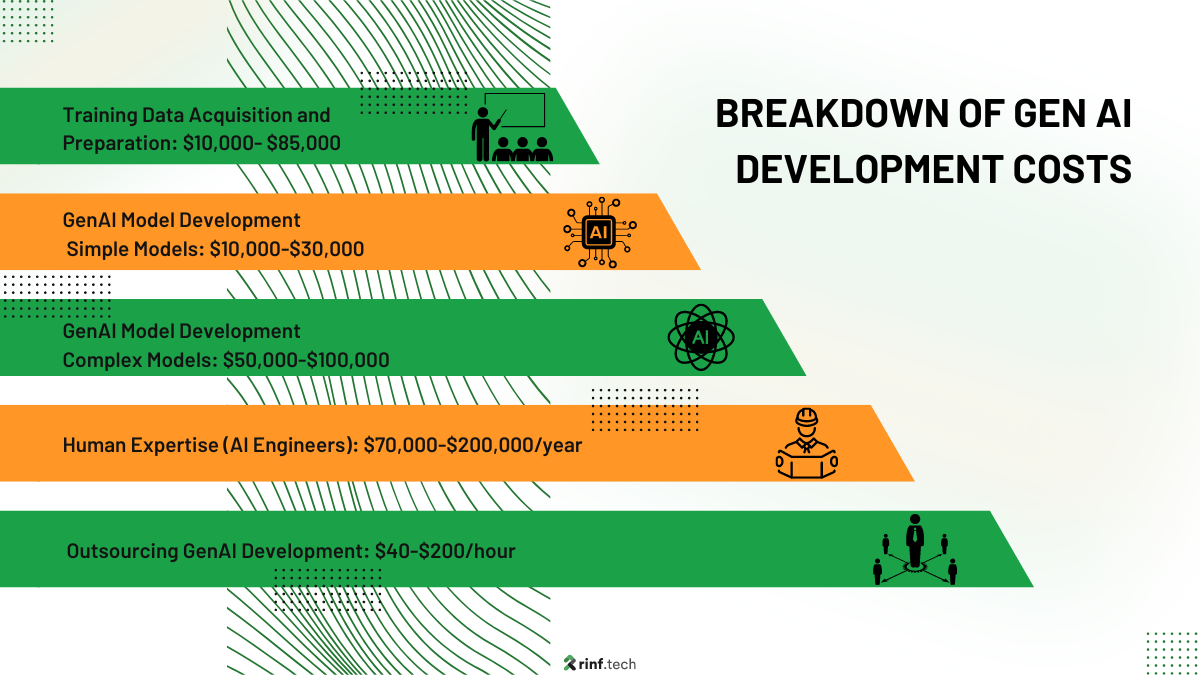The costs associated with GenAI-powered software development are substantial and diverse. However, when strategically managed, these investments can produce considerable efficiencies, innovations, and competitive advantages, aligning with broader market trends toward automation, intelligence, and personalized user experiences in software development.
Training Data Acquisition and Preparation
The journey toward leveraging GenAI begins with acquiring and preparing high-quality training data. This step is critical, as a GenAI model’s efficiency is directly tied to its training data’s quality, diversity, and relevance. The costs associated with this phase can vary widely, depending on the field and complexity of the tasks the model is expected to perform.
Data labeling and cleaning, essential for reducing model bias and improving accuracy, represent a substantial portion of these costs. Depending on the nature of your data and the complexity of your project, a solid dataset will cost anywhere from $10,500 to $85,000. Moreover, as data privacy and ethical considerations gain importance, the costs of ensuring compliance with regulations and ethical guidelines are also becoming significant factors for companies to consider.
GenAI Model Development
Developing a GenAI model involves a wide array of costs, the biggest of which are computational resources. Training complex GenAI models often requires significant cloud computing power, resulting in hefty expenses, especially for models requiring multiple iterations to refine and improve. Therefore, the cost of a generative AI solution depends on whether you’re using your own hardware or cloud services, with the latter’s price varying based on the cloud provider and the scale of your operations.
If you opt for a simpler model and deploy it on-premises, you’re expected to spend $10,000–30,000 in GPU costs to fine-tune the generative AI solution. With cloud computing, the expenses could range between $1 and $10 per hour, depending on instance type. GPT-3-like open-source models require a more advanced GPU setup, upwards of $50,000–$100,000. For high-end GPU models, the associated cloud computing expenses can range from $10 to $24 per hour.
Beyond computing costs, the expertise required to develop, train, and manage GenAI models is another critical expense. The demand for professionals skilled in AI and machine learning far exceeds supply, leading to premium salaries for this talent. Artificial intelligence talent doesn’t come cheap. A US-based in-house AI engineer will cost your company $70,000–$200,000 annually, let alone the hiring, payroll, social security, and other administrative expenses. You can reduce GenAI costs by partnering with an offshore software engineering company with AI development expertise. Depending on the location, enterprise-grade offshore partners typically charge $40-$90 per hour for a software engineering talent with AI skills. However, depending on project complexity, the hourly rates for a senior data scientist or ML engineer with unique expertise can reach and exceed $200 in Europe and Latam.
Additionally, software licenses for development tools and platforms add to the financial outlay. As GenAI technologies evolve, staying at the cutting edge may need ongoing investments in training and tool upgrades, ensuring that development teams have access to the latest advancements in the field.
Integration and Iteration
Integrating a GenAI model into existing software systems introduces a new set of challenges and costs. Developing robust data pipelines to feed real-time data into the model, creating APIs for model access, and ensuring the GenAI components work seamlessly with legacy systems are all crucial steps that require careful planning and investment. PwC highlights GenAI’s transformative potential in enhancing capacity, productivity, and augmentation, suggesting that these investments can lead to substantial long-term benefits for organizations.
Integrating the AI model into your existing systems and deploying it (especially in a production environment) requires additional software development efforts, which means labor costs entail substantial outlays for employing skilled developers. Given the advanced nature of GenAI integration, the demand for expertise in this niche significantly increases the project’s labor costs. This need for skilled labor spans across the development, integration, and iteration phases, underscoring the importance of strategic planning and investment in human resources to ensure the successful deployment and operation of GenAI technologies within existing software ecosystems.







